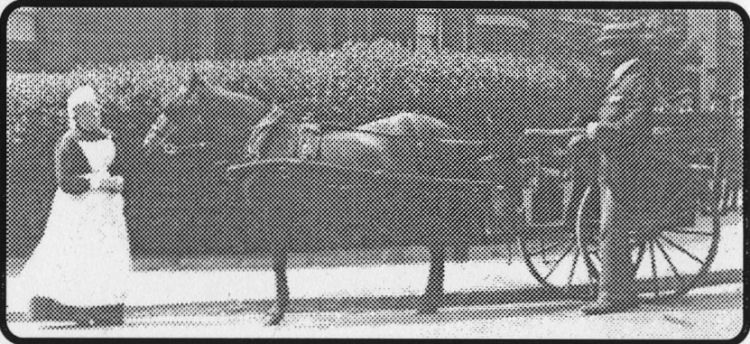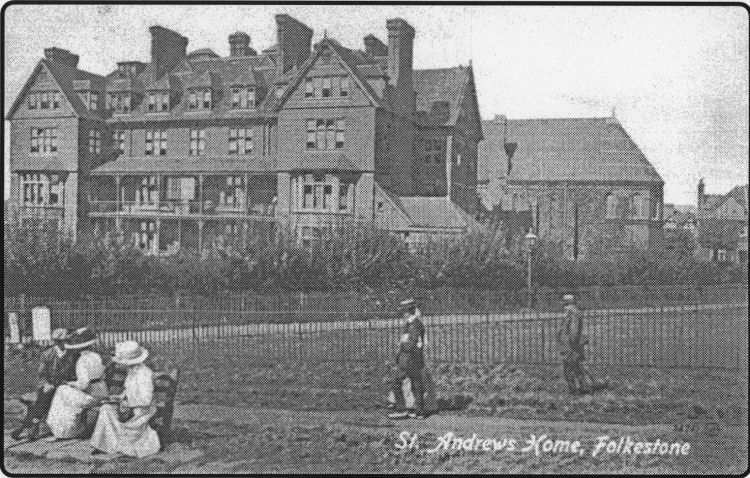
Published 28 August 2003


MEMORIES reader Paul Emden, who lives in one of the flats at St Andrews,
at The Durlocks, has made a nice little collection of old pictures of the
property when it was St Andrew’s Convalescent Home and also a guest house.
Some of the flats command good views over the harbour.
Paul has kindly sent me copies of his photographs with a little background
information about the property, for use in Memories.
I particularly like one which shows the Matron of the home in 1917 and a
pony trap used to give rides to the inmates, which meant going up and down
the steep Durlocks and North Street, says Paul, who pointed out that the
trap was in the charge of a coloured man. (The photo was taken at the
junction of The Durlocks and East Cliff Gardens.)
The St Andrew’s home, he says, moved from its original site in Guildhall
Street, to its prominent site overlooking East Cliff and the port 120 years
ago, the cornerstone being laid by the then Duchess of Edinburgh.
The home was run by the Order of the Nuns of Clewer and a chapel was added
in 1889.
At one time, says Paul, the home was for patients recovering from TB and
those staying there during their convalescence included men, women and
children.
“At some time, probably after the First World War, it became a WTA (Workers
Trade Association) guest house,” and this use may have continued after the
Second World War, he believes. During the war he understood it was used as a
billet for Canadian troops.
Because of its prominent position it is not surprising, he says, that during
the war anti-aircraft guns were sited in the gardens and the remains of the
metal rods which helped secure them can still be seen.
“After the war the home closed and was re-opened as the Continental Hotel
until its conversion to 27 flats around 1990.
“Should anyone have any further information regarding this wonderful Grade
II listed building, or any early photographs or memorabilia I would love to
hear from them, as I am very keen to records its history. It is a well
preserved building and one Folkestone can be proud of,” writes Paul, who can
be contacted on 01303 249923.
More Durlocks memories
Peter Croucher contacted me about recent Memories references to The Durlocks,
Folkestone, to say he was born in No 24, in 1928 and his sister at No 2 in
1923.
“I am now living in Southwater, West Sussex, having left Folkestone in 1950
and would very much appreciate a copy of any article or photograph,” he told
me in an e-mail message. He can be contacted on peter.croucher@btinternet.com
Still on the subject of the Durlocks and “Estate pride,” I also heard from
Mrs D.L. Rawlings, of Kennington, Ashford, who points out that the
foundation stone for
the Durlocks was laid by Lady Rocksavage on December 27, 1919 and this was
reported in the Folkestone Herald, of January 3,1920. It might, she
suggests, warrant a mention in Memories sometime.
•Reader Ron Dutt, another old boy of Dover Road School, told me he was one
of the lads who visited the old Ashford Railway Works with a school party,
which included Dennis Stone, in 1947, and he remembered Sir Eustace
Missenden very well.
“I have got a photograph of all us boys outside the works itself,” he told
me in an e-mail message.
•Folkestone & District Local History Society’s next diary date is September
3, when the subject of the meeting is a talk about ‘Kent’s Secret Army’, by
local history enthusiast and author David Collyer, of Deal. The Society
meets at Holy Trinity Church hall, in Sandgate Road, at 7.30pm for an 8pm
start. New members and visitors are welcome.
Landmark
 |
Dover Road builder wins contract for port station
"I QAQ LOCAL fishermen were reporting a X3Ui3bad season. Since April
strong winds had prevented them fishing most days, according to one
boatman, who complained it was the worst season for the 20 years he had
worked from the beach. Dover Road builder Mr Grayling, who built the
railway carriage works at Ashford, won the contract to pull down the old
wooden railway station at the harbour and build a new one. "Lord George
Sanger, the Greatest Showman of them all, is coming with his Gigantic
Colosseum of 1,000 years ago and today, with the only Real Hippodrome in
the World to Sandgate Hill, Folkestone, Friday, September 4, 1903," that
was how this well-known circus advertised its show in the Herald a
century ago. Other delights promised at the 'Colosseum - said to be
7,000 yards in circumference - included a 'realistic' production of an
Indian wedding, a massive parade of North American animals, together
with camels and elephants, a real Indian encampment, a prairie on fire,
the seemingly inevitable battle: scene between cowboys and Indians, and
a chariot race featuring 'real Indians.'
|
Flying golfer and partner win strange game of golf
'I QOQ RULES must have been "adjusted" for X«7^0a curious game of golf
played on an east Kent course which was recorded by the Herald. It
involved Mr K Edgson Wright, a passenger flying in an aircraft lent by
the Royal Cinque Ports Flying Club, and a partner, Mr P Cue, down on the
course. The game was played over six holes and the 'airmen' beat the 'groundsmen,'
Messrs W Meadmore and W Glover, who played in the conventional manner,
after the two sides were level at the final hole. In the aircraft flown
low over the course by Major I Clark, Mr Wright waited until the
opponents reached the first green then dropped his ball on the green,
this counting the same as the two strokes taken by the others to reach
that point. Mr Cue then took over to 'pot' the ball. The first two holes
were halved, then the airmen went ahead by one stroke. The next was
halved but the groundsmen levelled at the fifth. At the final hole the
airmen won by five strokes to their opponents' six. Sharp & Sons, dairy
farmers of Folkestone, who had premises at 37 Sandgate Road, took first
prize for their finely turned out dairy cart, at the Kent County
Agricultural Show held in Folkestone in the summer of 1928. The pony
cart featured in a photograph in the paper.
|
Heatwave Venetian Fete draws crowd of 30,000
•f qpq GREAT figures in the history of JL5/530 England came to life in
an impressive pageant called 'Star of England' at Hythe cricket ground
as a special feature of the town's cricket week. Hythe Venetian Fete, on
the hottest night for 24 years attracted a crowd 30,000 strong and, late
into the evening, many were still in their shirt sleeves. The event was
enhanced for spectators by the professional commentary of BBC
personality Michael Barsley. In pride of place at the head of the
procession of floats were Mrs and Mrs William Curd, of Victoria Avenue,
Hythe, on a traditional Darby and Joan float, depicting a couple living
in peace and serenity, sat by the fireside of their humble home,
complete with carpet! Billed as a £150,000 spectacle, under Europe's
biggest 'Big Top,' the Chipperfields' circus came to Morehall,
Folkestone, for three days in the third week of August. Roman chariot
racing was one of the attractions, while advertising boasted of a
procession of over 200 performing animals, with 16 Ceylonese elephants,
18 polar and black bears and 14 African lions.
|
Trouble shooter Tony Benn flies in to power station
•1 Q■70 SOME 1,000 valuable rainbow trout aL«7 I Owere among fish lost
as a result of polluted local waters, a serious blow to a new growth
industry. Pressure was being applied to discover the cause and
compensate fishery owners. One-time Herald editor David Wynne-Jones
opened Cheriton primary school fete, held to raise more funds for a
cover for the school's swimming pool. David was better known to many
local children as 'Professor Bullseye' of the children's page in the
Herald"s former mid-week paper the South Kent Gazette, Energy secretary
Anthony Wedgewood-Benn was due to fly in on a fact-finding visit to
Dungeness Power Station which was hit by industrial trouble. Mayor of
Folkestone Cllr Ivy Allan tested her puff trying to play a euphonium in
the mayor's parlour. It was part of a move to form a new Folkestone town
brass band, with Frank Gale as bandmaster and the mayor backing the
idea, The public library •taged an exhibition to mark a special
anniversary, called William Harvey and 400 years of medicine, with
emphasis on the growth of medicine in Kent. The event coincided with the
30th anniversary of the National Health Service. |
|



